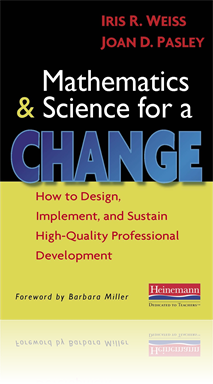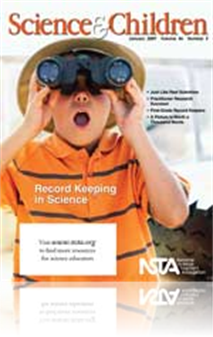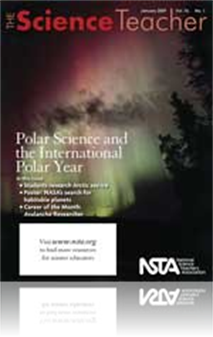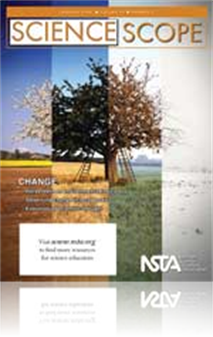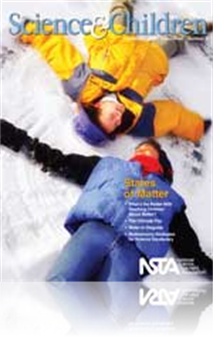All Resources
Acquired Book
You’ve decided it’s time for something different. A new way to teach mathematics and science that supports higher achievement in all students. And that means rethinking how you provide teacher professional development. Sounds like a tough task, b...
Journal Article
Point of View: Smooth Handoff—Alignment of Secondary and Collegiate Learner Goals in Science
A winning science education relay is tough to pull off if high school and college instructors misunderstand each other. Difficulties in learner transition to college science appear to have roots in miscommunication: what high school teachers think co...
Journal Article
Process Skills Practice and Standardized Tests
Faced with the prospect of giving fifth graders a state science test, teachers often review previous grade-level science content or use test-review booklets as a method of preparation. While this may allow students to understand testing rules, such t...
Journal Article
The fume hood: You know what it is, but have you ever used it? And if a safety issue arose, would you know what to do? Unfortunately, fume hoods are frequently included in a science room just for show. Little thought is often given to how they should...
Journal Article
Editor’s Roundtable: Threads of change
Egg, larva, pupa, adult, done! How easy it would be if teaching students to grasp the nature and role of change was that simple! Getting students to observe and attend to the changes around them—in their natural surroundings and in the laboratory�...
Journal Article
Science Shorts: Organizing Weather Data
Often in schools, children collect weather data as part of their morning meeting or calendar time. These common primary level activities lend themselves nicely to introducing the importance of organizing data. In this lesson, children and teacher wo...
Journal Article
Scope on the Skies: International Year of Astronomy
This year marks the 400th anniversary of when a telescope was used for astronomical observations, and 2009 has also been designated the International Year of Astronomy—a yearlong celebration of astronomy through various events and activities both o...
Journal Article
An O-“fish”-ial Research Project
In this “O-“fish”-ial” research project, third-grade students use multiple resources to research several fish species, write a research paper and develop a PowerPoint presentation to communicate their findings. In addition, students actually ...
Journal Article
A Simple Exercise Reveals the Way Students Think About Scientific Modeling
Scientific modeling is an integral part of contemporary science, yet many students have little understanding of how models are developed, validated, and used to predict and explain phenomena. A simple modeling exercise led to significant gains in und...
Journal Article
Take Off With NASA’s Kepler Mission!
Humans have long wondered about life in the universe. Are we alone? Is Earth unique? What is it that makes our planet a habitable one, and are there others like Earth? NASA’s Kepler Mission seeks the answers to these questions. Kepler is a space-ba...
Journal Article
Clarifying ancient environments millions of years ago is necessary to better understand how ecosystems change over time, providing insight as to the potential impacts of current global warming. This module engages middle school students in the scient...
Journal Article
Integrating Interactive Notebooks
An interactive notebook can be a powerful instructional tool, allowing students to take control of their learning while processing information and engaging in self-reflection. The three-part learning cycle of an interactive notebook makes it easy to ...
Journal Article
Scope on Safety: Allergies—Nothing to sneeze at
The list from the nurse’s office of students with known allergies seems to get longer each year. Allergy symptoms can range from a simple red rash or itch to life-threatening anaphylactic shock. Interestingly enough, peanuts and tree nuts account f...
Journal Article
Enabling a Culture of Change: A Life Science Faculty Learning Community Promotes Scientific Teaching
Significant challenges to education transformation in lecture-oriented science departments include initiating and supporting a dialogue about teaching and learning among faculty whose priorities are primarily research. The authors established a facul...
Journal Article
Perspectives: ELLs and the Language of School Science
In science, language denotes the relationship among ideas (e.g., cause/effect; instance/generalization; individual/group member), with features that are often subtle and abstract. Such features of science language make school science difficult for al...
Journal Article
Science 101: How does a scientific theory become a scientific law?
A theory doesn’t become a law. End of story, end of this issue of Science 101. Just kidding—it’s all about the how and why, and that hasn’t been answered. See if this sounds familiar: Scientists begin with a hypothesis, which is sort of a gu...
Journal Article
Favorite Demonstration: Biological Membranes
This demonstration provides an excellent example of how eukaryotic cells are compartmentalized and how important the bilipid layer of the endomembrane system is in providing this sectioned architecture. This demonstration also effectively depicts how...
Journal Article
Safer Science: Personal Protective Equipment—It’s the Law!
In addition to the Occupational Health and Safety Administration (OSHA) personal protective equipment (PPE) standard—OSHA Laboratory Standard 29CFR 1910.132—and other professional prudent practices, many states have protective eye devise statutes...
Journal Article
Every Day Science: January 2009
This monthly feature contains facts and challenges for the science explorer. ...
Journal Article
Developing good record-keeping habits is essential for organizing, processing, and communicating experimental results objectively. Therefore, the authors designed an interactive method of teaching first graders to record, organize, and interpret data...
Journal Article
Case Study: Uretero What? Gynecological Health Issues, Pregnancy, and an Infant With a Birth Defect
This case study follows the life of a successful career woman who is faced with a series of medical problems and career decisions. The purpose of this case study is for students to apply systems-level physiology as they explore a pregnancy with medic...
Journal Article
Tried and True: Modeling changes in matter, magnifying interest in science
At Daniell Middle School in Marietta Georgia, students’ interest in science and understanding of matter has been magnified. This is due, at least in part, to science faculty, who are convinced that a hands-on, inquiry approach to science can stimul...
Journal Article
Recently, senior-level physics students joined thousands of scientists from over 60 nations to examine a wide range of physical, biological, and social research topics as part of the International Polar Year (IPY). Through a National Science Foundati...
Journal Article
The SATELLITES program uses geospatial technologies to study surface temperatures of Earth’s materials, such as sand, soil, grass, and water. Data are collected using Global Learning and Observations to Benefit the Environment (GLOBE) protocols, wh...
Journal Article
Teaching Through Trade Books: Communicating With Pictures and Precision
From the earliest civilizations, humans have used drawings and pictures as a form of communication and to convey information—whether it was the seasons or location of good hunting grounds. In this month’s column, simple alphabet picture books sho...
Journal Article
Scope on the Skies: Mars at opposition
On January 29, Mars will reach opposition, a point along its orbit around the Sun where Mars will be directly opposite from the Sun in a two-planet and Sun line-up with the Earth in between. At this opposition, the Earth and Mars will be separated by...
Journal Article
Editor’s Roundtable: What students can learn in their own backyard
Local resources and potential science education partners are underutilized, though many facilities, institutions, and professionals would gladly volunteer time and services to schools and teachers. This issue of Science Scope offers a collection of a...
Journal Article
Digging Into Inquiry-based Earth Science Research
To help eighth-grade students experience the excitement of Earth science research, the authors developed an inquiry-based project in which students evaluated and cataloged their campus geology and soils. Following class discussions of rock-weathering...
Journal Article
This paper describes a one-and-a-half day Distinguished Scholar Symposium during which undergraduate underrepresented minorities (URMs) from nearby schools visit the University of North Carolina at Chapel Hill (UNC-CH) to learn about advanced degree ...
Journal Article
Multisensory Strategies for Science Vocabulary
Seeing, touching, smelling, hearing, and learning! The authors observed that their English Language Learner (ELL) students achieved a deeper understanding of the properties of matter, as well as enhanced vocabulary development, when they were guided ...
Journal Article
The implementation of standards and high-stakes testing has increased the pressure on classroom teachers to cover content in what seems like an ever-shrinking period of time. What if there was a way to help students pay better attention and remember ...
Journal Article
This project-based science unit, focused on a local environmental issue, created a great deal of interest and learning, as well as drew in the support of the community. The authors designed and implemented the project in a fifth- and sixth-grade clas...
Journal Article
Many recipes for elementary science activities suggest making carbon dioxide from baking soda and vinegar; however, they often do not give exact measurements of the ingredients. The author was able to turn this “drawback” into a plus by challengi...
Journal Article
When students understand content deeply, they recognize main concepts and understand the relationships among ideas. But the typical processes students use to study are generally not designed to generate conceptual understandings. Instead, they tend t...
Journal Article
As biology teachers, we should embrace the ever-increasing appearance of biology in movies and other media as an opportunity to engage students in active learning and to facilitate critical-thinking and investigative skills in the classroom. In this ...
Journal Article
This article presents a lesson plan in which students learn about water in solid, liquid, and gaseous phases through trade books, demonstrations, and artwork. The author illustrates the stages of the lesson plan in the sequence they were conducted in...
Journal Article
Dinosaur Extinction, Early Childhood Style
Do dinosaurs have bellybuttons? This intriguing question launched a journey into inquiry science that captivated a class of four-year-olds for eight months. As students enjoyed dinosaur books, examined dinosaur artifacts, drew pictures, watched video...
Journal Article
Idea Bank: Changing Misconceptions
During student-centered learning activities, students actively engage in their own learning based on individual prior understandings. It can be difficult for a teacher to know if students fully understand the concepts being presented, especially if t...
Journal Article
Commentary: Leading Beyond the Classroom
Science and science education have had many great leaders, some of whom may not have thought of themselves as leaders while engaged in their work. This holds true for many teachers, who think they do not have the time or experience to be a great lead...
Journal Article
Lighting the Way Through Scientific Discourse
This article describes a thought-provoking lesson that compares various arrangements of lamp-battery circuits to help students develop the motivation and competence to participate in scientific discourse for knowledge construction. Through experiment...



